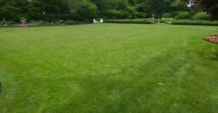If you haven’t noticed yet, hordes of goldenrod soldier beetle (Chauliognathus pennsylvanicus) adults are feeding on goldenrod (Solidago spp.) and other flowering plants such milkweed (Asclepias spp.). Adults are extremely abundant feeding on the flowers of chive (Allium Schoenoprasum), and can also be seen feeding on linden trees (Tilia spp.) when in bloom. In fact, adults may be observed both feeding and mating (occasionally at the same time). The goldenrod soldier beetle is common to both the western and eastern portions of Kansas.
Adults are about 1/2 inch (12 mm) in length, elongated, and orange in color with two dark bands on the base of the forewings (elytra) and thorax (middle section). They are typically present from August through September. Adult soldier beetles feed on the pollen and nectar of flowers, but they are also predators and may consume small insects such as aphids and caterpillars. Flowers are a great place for the male and female soldier beetle adults to meet, get acquainted, and mate (there is no wasting time here). Soldier beetle adults do not cause any plant damage. Sometimes adults may enter homes; however, they are rarely a concern. The best way to deal with adults in the home is to sweep, handpick, or vacuum.
Adult females lay clusters of eggs in the soil. Larvae are dark-colored, slender, and covered with small dense hairs or bristles which gives the larvae a velvety appearance. Larvae reside in the soil where they feed on grasshopper eggs; however, they may emerge from the soil to feed on soft-bodied insects and small caterpillars. (Raymond Cloyd)




